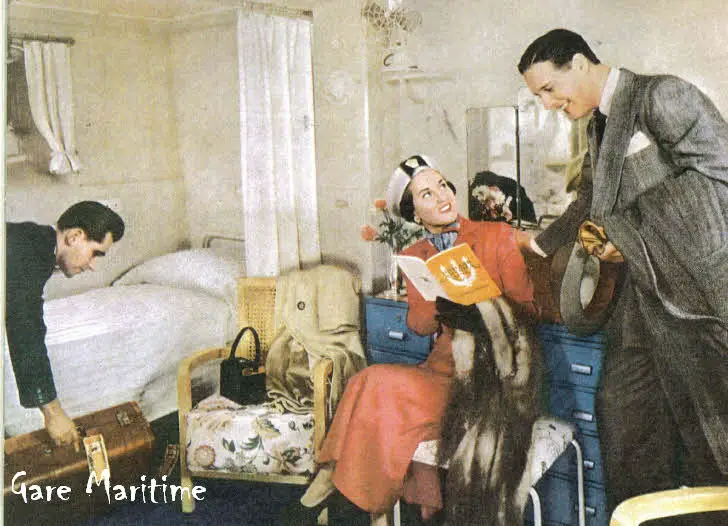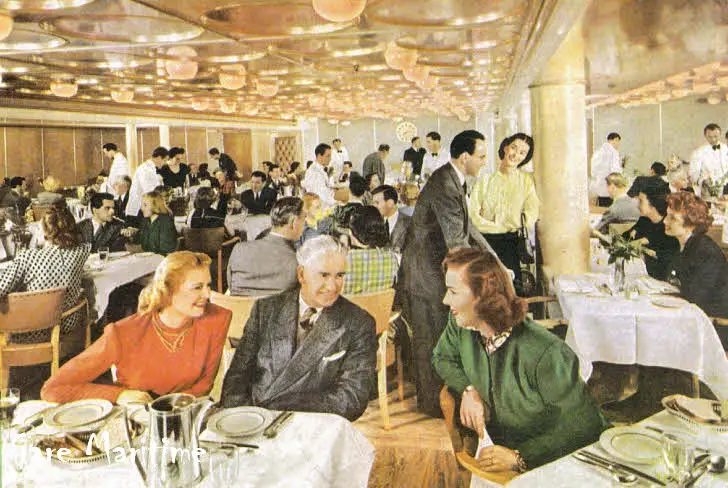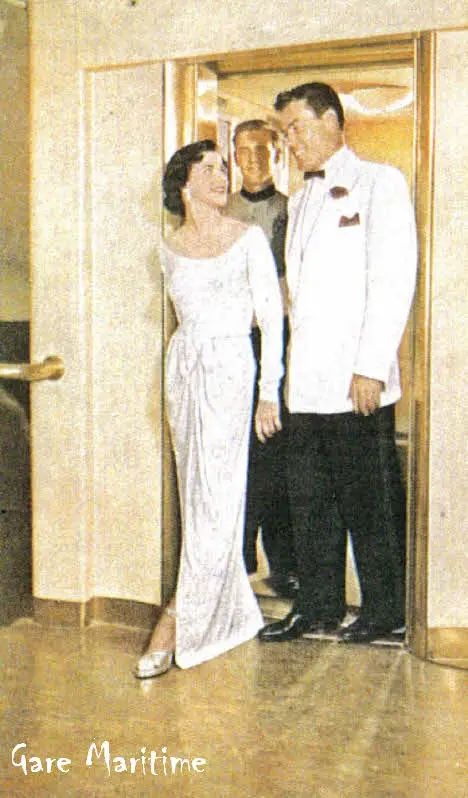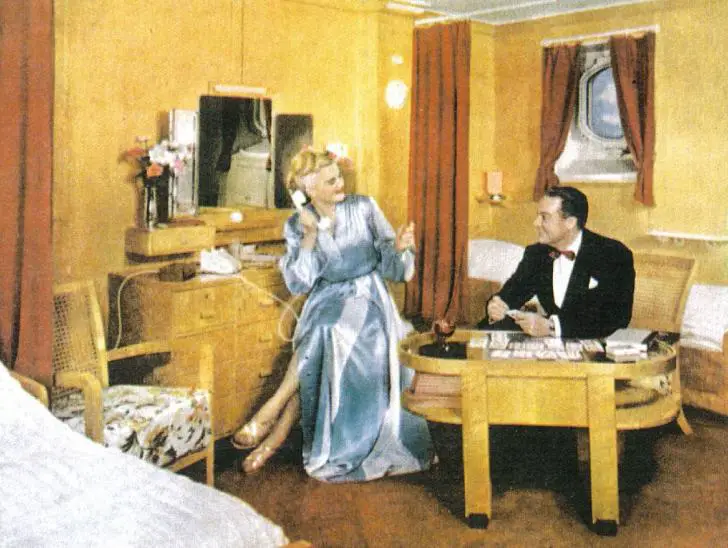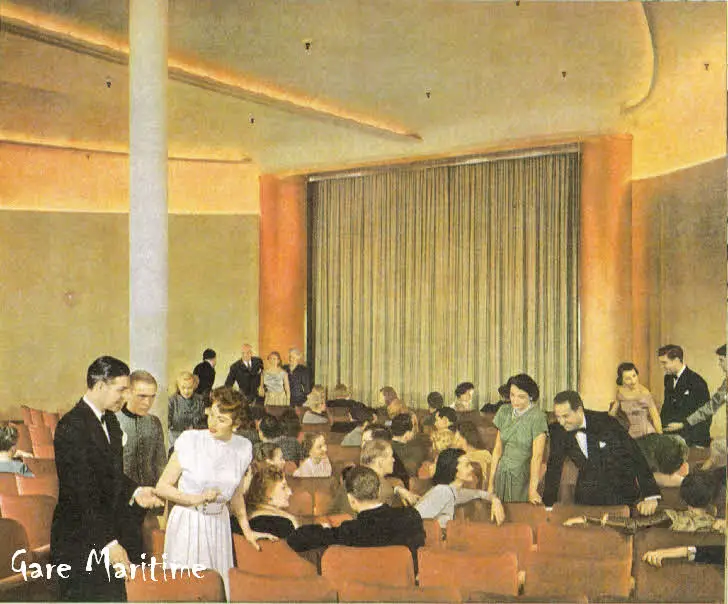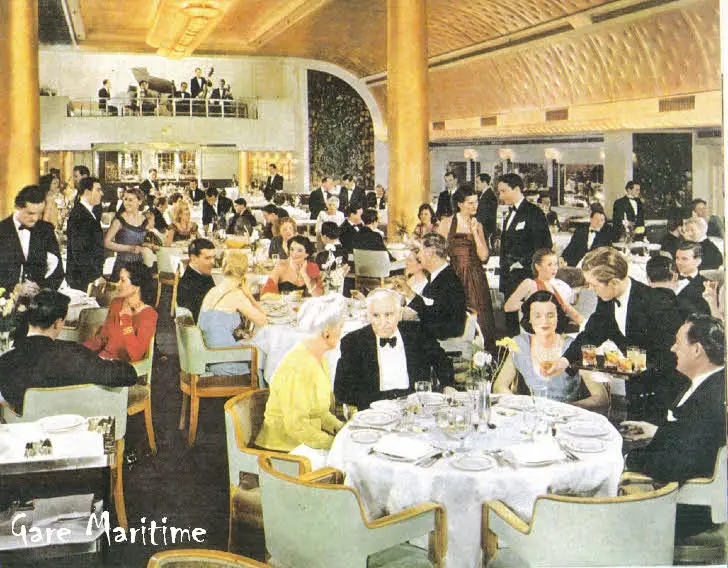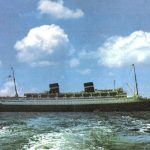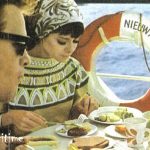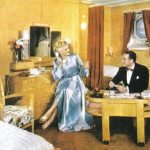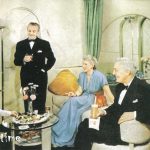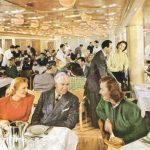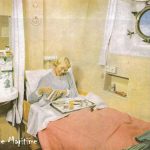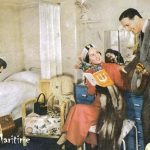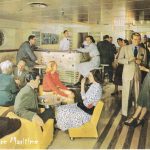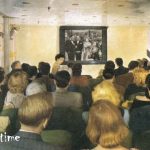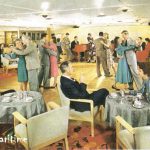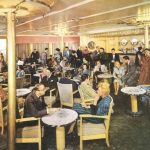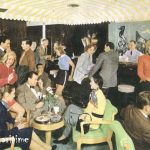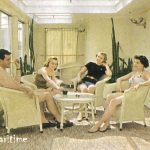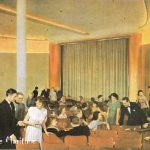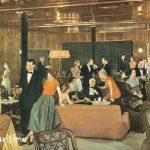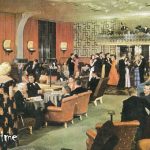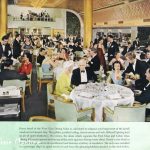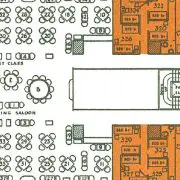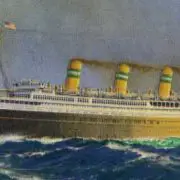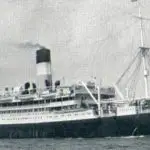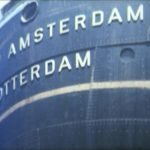The Art and Architecture of the Nieuw Amsterdam
2. Postwar Finery
Courtesy of Tim Yoder

|
To celebrate the return of the Nieuw Amsterdam to transatlantic service, Holland -America issued a particularly lavish brochure, equal to any of her pre-war press material, showing most of her public spaces in color. The extensive shoot utilized dozens of models, clad in stylish day and evening outfits provided by Bonwit Teller, making the booklet not just a great source of photos of the liner but also a nice document demonstrating the high-style of postwar prosperity.
Counting the rivetsThe Nieuw Amsterdam had an overall length of 758 feet, 6 3/8 inches. Her length at the waterline was 725 feet, 11 inches, and her length between perpendiculars 700 feet. Her beam, molded, was 88 feet, and her depth molded to the Cabin Class Sun Deck was 99 feet. Her height, from keel to funnel tops was 147 feet, and keel to masthead 205 feet. The Nieuw Amsterdam’s load draft was 31 feet 6 5/16 inches. Her gross registered tonnage was 36,667 (1947) her displacement tonnage 36, 235 (1947) and her net tonnage 21, 744. She was powered by two sets of Parsons quadruple expansion single reduction geared turbines, which developed 34,000 S.H.P. for propulsion purposes. Her three turbo generators developed 3000k.w. 220 volts direct current. Two sets of Werkspoor Diesel generators developed 950 k.w. 220 volts direct current, available while the ship was in port or in emergency situations. Two emergency Diesel rotors of 50 k.w. each were placed under the after funnel. The boiler installation consisted of six Schelde-Yarrow boilers with a capacity of 30 tons of steam per boiler per hours. Five boilers were sufficient to maintain the pressure necessary to operate the ship. The sixth boiler served as a reserve. The working pressure of the boilers was, at the outset, 550 lbs per square inch, and 743F. A Scotch boiler with a heated surface of 2,800 square feet and a working pressure of 150 lbs per square inch was placed in the same boiler room and used when the ship was in port for heating and galley purposes. All of the boilers burned oil. Each of the turbines had a gearwheel of 14 feet, diameter, weighing 50 tons. The turbines contained approximately 160,300 blades. The blades in the super high pressure, high pressure, and intermediate pressure turbine were made of ATV steel to provide sufficient resistance under the high temperature conditions. The blades of the low pressure turbine were made of manganese copper. Steam of 142 lbs. per square inch led directly from both high pressure turbines to the high pressure feed heater and to the laundry; steam of 85 lbs. square inch was also taken from the high pressure turbine for hotel service and fuel oil heating. Steam of 60 lbs,. per square inch was used for the intermediate pressure feed heater, and steam of 50 lbs. per square inch was led directly from the turbine driven feed pumps to the evaporator. In that way only about 70% of the total steam weight reaches the condenser. Each set of turbines was connected with one main condenser, having approximately 13,300 square feet of cooling surface. The condensers were of the Ware regenerative type and had a mean vacuum of 28.75 inches when the engines were developing the normal shaft horsepower. Salt detectors with electrical alarms were fitted in condensate pressure lines of each condenser. She was a twin screw liner, with triple-bladed manganese bronze air-flow propellers, weighing 22 ½ tons each. At full speed they made 131 revolutions per minute. During the summer of 1967, The Nieuw Amsterdam experienced the first near-catastrophic event of her 29 year career, when a mechanical breakdown forced the cancellation of most of her peak-season crossings. The end might have come there, but boilers were acquired from a U.S. Navy vessel being scrapped in California. They were exported to the Wilton-Fijenoord shipyard in Holland and, after a huge hole was cut in the liner’s side, installed, buying the “old favorite” more time. The Nieuw Amsterdam’s funnels measured 41 feet from base to top and had an extreme diameter of 35 feet and a circumference of about 85 feet. The after funnel contained a complete set of fresh water filters with a capacity of 80 tons per hour, fuel tanks, sanitary tanks and suction ventilators for galley odors. Six Vortex dust collectors were installed in the uptakes with suction fans to eliminate solid particles from combustion gases. Each funnel carried an electrically operated steam whistle. A Jensen Howler foghorn was installed at the liner’s bow which could be heard for 15 miles across the water but was inaudible inside the ship’s public areas. A Grinnell automatic sprinkler and fire alarm system was placed aboard the Holland-America Line’s flagship. 3,600 sprinkler heads throughout the passenger and crew sections of the liner were capable of emitting a jet of water strong enough to reach higher than the ship herself. There were 35 automatic simultaneous alarm bells aboard the Nieuw Amsterdam. She carried 125 hand extinguishers, which were placed at regular intervals. There were 68 fireproof doors above A Deck, and 48 sliding doors on B Deck and below that served as both fireproof and watertight doors. These 48 doors divided the ship into 12 watertight compartments. Her double hull was further divided into 42 watertight compartments, which were used for fresh feed, fuel and lubricating oil. She carried 22 Birmabright aluminum lifeboats with a total capacity of 1,946 persons. Six of these boats were motorized. The davits were Barclay Gravity types, and the lifeboat gear was arranged with the intent of boarding the boats from the Upper Promenade Deck should the need have arisen. The liner also came equipped with 2,452 life preservers. 23 rafts, with a capacity of 506 persons were carried as reserves. The Nieuw Amsterdam, fortunately, never had to put her life saving devices to the test: in her 35 years of service it seems that her most serious accident was a collision with a railway barge in New York Harbor in January 1965. The Nieuw Amsterdam in her 1938 and 1947 configurations, was extensively air conditioned, with both movie theaters, barber shops and all three dining rooms benefiting. The system operated entirely by electricity and was capable of producing cooled air equivalent to an amount given off daily by 300 tons of melted ice. It also dried the air and provided regular circulation in the course of which 25% of it was renewed. The pressure of the air in the conditioned rooms was kept slightly above that of the atmosphere to prevent outside air from flowing in. it was possible to maintain an average of 70F with an outside temperature as low as 10F. All First and Cabin Class staterooms had electric heaters. Two hundred electric heaters in the public rooms supplemented the capacity of the ventilating system. During the 1956-’57 refit, the entire ship was air-conditioned, allowing her to remain competitive with the new breed of liners being introduced. By doing this before lack of central air conditioning became a complete detriment, Holland-America insured that the liner would maintain her reputation for comfort. Many older liners were not as “fortunate” and would not be air conditioned until after it became the norm rather than the exception, fostering negative word of mouth that the pre-War liners remaining in service were “uncomfortable.” The Nieuw Amsterdam had 546 cabins, of which 374 had private bathrooms. There were 1,062 portholes and sidelights aboard, with a total surface area of 17,000 square feet. The public rooms and cabins were fitted out with the following woods: Bird’s Eye Maple; Avodire; Patapsco; Sycamore; Figured Birch; Ash; Burma Mahogany; Chestnut; Silver Sycamore; Aspen; Bird’s Eye Ash; Mountain Ash; Figured Cherry; Rio Rosewood; Laurel; African Cherry; Walnut; Indian Silvergrey; Sapeli Mahogany; Weathered Satinwood; Matore; Macassar Ebony; Silky Oak; Bubinga; Brown Oak; Zebrano. The Nieuw Amsterdam underwent several refits after her 1947 return to the North Atlantic. In 1952, a balcony bar was added to her Grand Hall; in 1956-’57 she was given an extensive internal upgrade during which time her public rooms and cabins were refurbished and her entire interior air-conditioned. It was at this time that the original hull color was changed from black to dove gray. In 1961, the title “Cabin class” was eliminated, with her former Cabin class being renamed Tourist class, and her redundant Tourist class public rooms replaced by a large-multipurpose room, the Henry Hudson Lounge. Her capacity then became 691 First Class/583 Tourist or 301 First class/ 972 Tourist.. Three groupings of dramatic elongated windows, on either side of the ship, were cut into the hull for the new Tourist class room, making it possible to immediately identify a photo of the ship as being pre or post 1961. The liner’s garage was capable of carrying 40 cars. Her total cargo capacity was 252,628 cubic feet. The Nieuw Amsterdam was an exceptionally economical ship to operate, by the standards of 1938 and 1947. Unlike her larger competitors, she had a compact power plant, with only one boiler room, one engine room, and one auxiliary machinery room. Her service speed, of 21.5 knots, was over 2/3 that of the Queen Mary or Normandie and achieved with a total horsepower of 34,000; almost 1/3 those of her rivals. Because of the smaller space allocated for the power and propulsion systems, the Nieuw Amsterdam had a large freight capacity relative to her size: although when the 938 foot, 51,731 ton Bremen passed through the Panama Canal in 1939 she was the longest and largest ship to have done so, the Nieuw Amsterdam in the same year earned the distinction of being the highest taxed ship to pass through-the rate being determined by the liner’s utilized space rather than size. Holland-America incorporated that fact into their advertising. |

